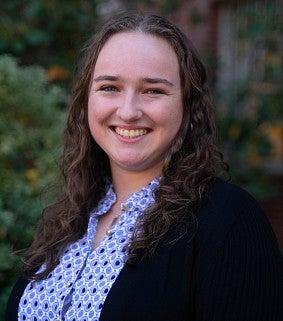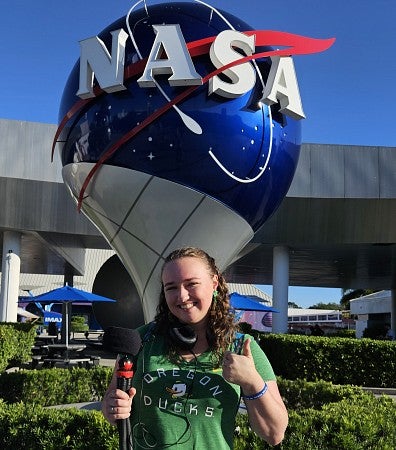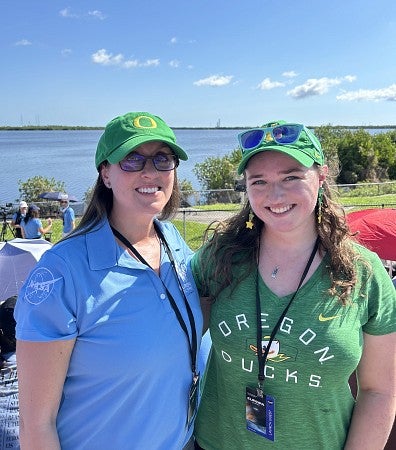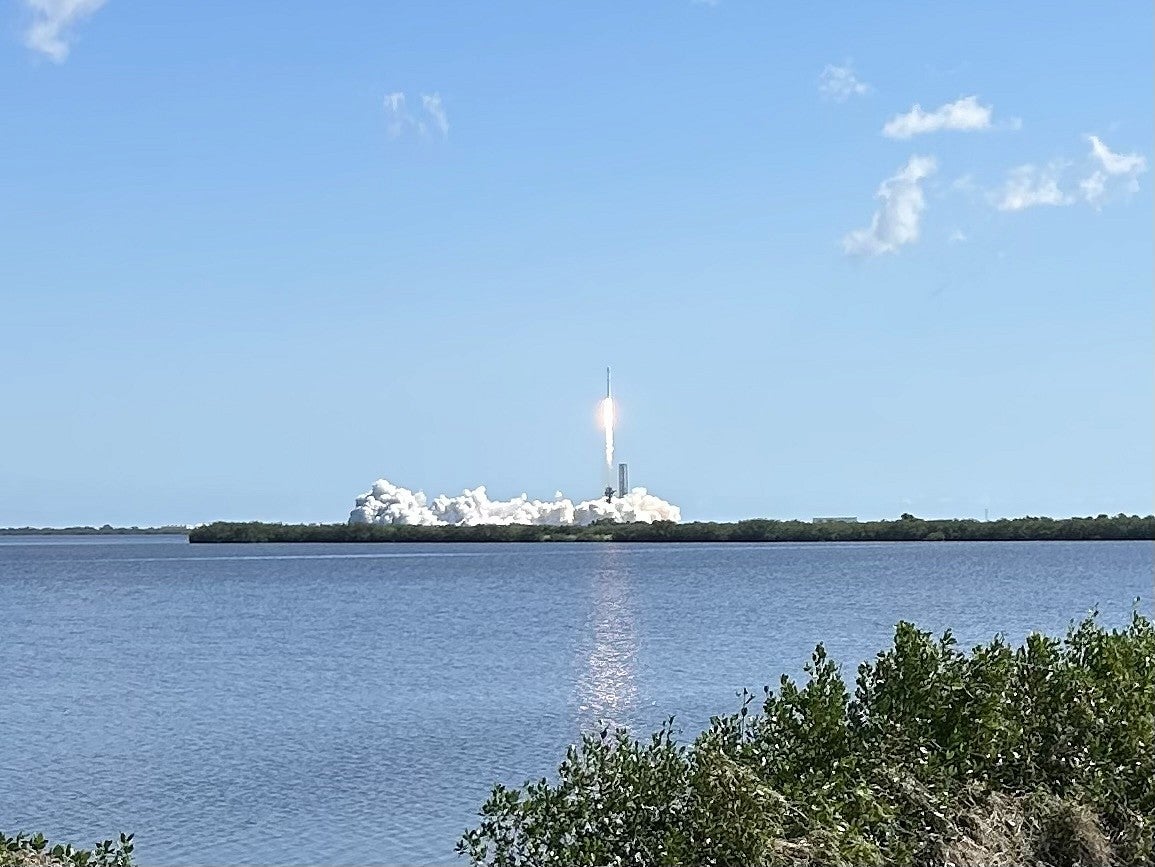
Hero Envelope Title
Hero Envelope Text
At the eye of the storm

Hometown: Hillsboro, Oregon
Role model: Wendy Lawrence, a female astronaut who broke barriers in both the U.S. military and NASA.
Favorite book: The Nightingale by Kristen Hannah
Coffee or tea: Coffee, 100 percent. Coffee hits the spot in a way that tea can only dream of.
Can’t live without: My Zoom H6 audio recorder. In my day-to-day life, I could not live without my Google calendar.
Favorite thing about the CHC: The emphasis on interdisciplinary studies and the ability to learn about topics I would not have time to learn otherwise.
Erin Morrison had flown into Florida in early October to visit a friend in Daytona Beach. They had just finished breakfast and were driving back to her friend’s apartment when the news broke: Hurricane Milton was coming, and it was ranked as a sure-to-be deadly Category 5 storm.
Morrison, a Clark Honors College senior, was in the state to watch the launch of Europa Clipper, the $5.2 billion NASA project headed to Jupiter to explore one of the planet’s icy moons. The launch is at the center of Morrison’s thesis project and she was excited to hang out with a friend before heading to Kennedy Space Center just north of Cocoa Beach.
“Well, should I still drive you down?” her friend asked.
“Yes,” Morrison replied, a hint of fear in her voice. “I don’t know where I’m gonna go otherwise.”
Morrison wasn’t completely alone in Florida. She was meeting up with UO’s Carol Paty, an earth sciences professor with the College of Arts and Sciences and a former faculty member and associate dean at the Honors College. As part of her research, Paty worked with a team of scientists to create some of the tools to help Europa Clipper study a moon 1.8 billion miles away.
According to NASA, there’s evidence that this moon might have the necessary ingredients under miles of ice to support life.
She sent Paty a text as she headed to her hotel ahead of the storm. “This seems like a pretty big deal. What do we know?” Paty encouraged Morrison to get to the safety of her hotel and assured her that they would connect.
If things went according to plan, it’d just be a matter of days before Morrison would watch the historic rocket launch from the Kennedy Space Center. The only thing standing in her way? Braving her first natural disaster. Morrison was nervous and panicked. But she was already preparing in her mind. “I just need to get to the hotel, and then I can make a game plan,” she remembers thinking.
She knew the hotel where she was staying was built for hurricanes. They hit Florida every year. Evacuating wasn’t an option because the roads heading north were congested with people fleeing their homes, and changing her ticket would’ve been a hassle.
Morrison recalls thinking: There’s no way I’m going to miss the launch. She didn’t want to miss the opportunity to watch history.


“There were definitely a couple moments where I was like: ‘What am I doing? I just want to go home.’”
Launch gets delayed
Europa Clipper was supposed to take off on Oct. 10, the same day Milton was projected to make landfall over Kennedy Space Center. Officials scrubbed the launch, prepared for the hurricane’s impact, and took safety measures to protect the rocket and the people working on it. It wasn’t clear at first whether the launch would happen later.
Morrison had never experienced a natural disaster, but she’s no stranger to emergency preparedness. In a way, she’s been chasing storms her entire life. Growing up, Morrison was known among her peers as the “Band-Aid friend” who always did well in crisis scenarios.
Luckily, she hasn’t had to deal with any serious injuries or accidents, but she says she’s “one of those people who has seen a lot of horrific car crashes” and that she’s had to call 9-1-1 a lot. Her motto? “Let's figure out some steps—make a plan of action,” she says.
Usually, Morrison keeps calm by leaning on those around her. This time, she was alone.
“There were definitely a couple moments where I was like: ‘What am I doing? I just want to go home,” she recalls. It was hard for her not knowing what would happen next, but she had some tools in her pocket to help her stay level-headed.
She turned to the knowledge she picked up from her UO earth science classes and her experiences participating in the university’s Outdoor Pursuits program. She had already taken several wilderness survival classes in the program and grew up hiking and camping, so she felt prepared. “I knew what I needed to do,” she remembers thinking.
Morrison got to her hotel four days before the hurricane hit and participated in meetings with the Project Science Group preparing for the launch. She walked to a nearby store and bought seven liters of water and an array of non-perishable food.
She remembers wondering if two cans of soup, a few instant lentil meals, yogurt, granola, apples, and the ingredients for peanut butter and jelly sandwiches would be enough. She hauled the bags back to her hotel room.
She returned to the store the next day after her mom called and encouraged her to get more supplies. She remembers thinking at the time: “OK, I can eat this cold…it doesn’t need to be cooked. If it’s heated up, it’s obviously better, right?” Either way, she had to be prepared if she lost access to water and electricity. She also bought Snickers bars and pudding cups.
She spoke often with her mom and watched the news, seeking out any information she could on the hurricane and its impact.
Before the storm hit, she noticed a welt on her leg that continued to grow. “I probably just got bit by something because it’s Florida, right? There are so many critters,” she says now. She worried the bite might lead to blood poisoning.
She headed to the emergency room at a nearby hospital for treatment and was struck by how empty it was. Doctors gave her a prescription for antibiotics and sent her on her way.

Bracing for Impact
The storm slowly made landfall on Wednesday. Morrison walked in the rain to a pharmacy a mile away, lightning flashing around her, followed by booming thunder. She clutched her prescription, trying to keep it dry.
She made it back to her hotel safely by the time the tornado warnings began. Several tornadoes touched down nearby. “Oh, they’re gonna be where I am,” she remembers thinking.
Morrison stripped one of the two queen beds, the one closest to the window. Using the bedding, she made a makeshift bed in the tub in the bathroom. She remembers being frustrated because she couldn’t see the storm. “If I’m experiencing this much fear, I at least want to see the thing I’m supposed to be scared of. But no, probably better than standing by my window during a tornado,” she told herself.
She stepped over the side of the tub and into her makeshift shelter, knowing that the peculiar bunker would become her home for the next several hours, maybe longer.
Morrison tuned to the National Oceanic and Atmospheric Administration radar feed on her phone, watching for live updates in her area. “I didn’t sign up for tornadoes,” she thought. “Maybe I can handle some strong winds, but tornadoes are out of my depth.”
She called her uncle, who works for NOAA. As they talked, two tornados came within a few blocks of her hotel. She braced for impact, but nothing happened. “My power is flickering, and I’m getting 50 percent of all my texts and calls at this point from lack of internet,” Morrison remembers. “The tornadoes were much scarier, in my opinion, than the hurricane.”
Two blocks away, a tornado that touched down next to Paty’s hotel had ripped the parking lot’s roof off. It destroyed a Wells Fargo Bank branch and the local Supercuts across the street.
By the evening, it was eerily quiet. The only thing Morrison could hear was the wind whistling through the air vent in the bathroom. While it was scary to be in the line of the storm, it was even more challenging for her to brave it alone.
She texted the friend she had had breakfast with, making sure he was safe at home in Daytona Beach. Whenever she could, she made calls to other friends and family members.
By 2 a.m. Thursday, the hurricane passed overhead. She noticed how the loud winds and air pressure changed, and its rattling of the vent kept her awake. Finally, she fell asleep. “I think I was just so stressed and overwhelmed that my body shut down,” she remembers.
She woke up the next day, stunned that the sun had come out and the sky was blue. Aside from Paty’s hotel, the Supercuts and the bank branch, Cocoa Beach didn’t suffer much damage.
Morrison planned to stay in her room all day because “you have to really be worried about downed power lines and things like that,” she says. But Paty texted her and invited Morrison down to the beach with her family.
The surf swell remained high from the storm and seashells littered the beach. “It was this gorgeous day,” Morrison recalls, as they discovered a variety of conch and junonia shells in the sand.

Preparing for takeoff
The launch took place on Oct. 14, a few days later. Paty had invited Morrison to attend nearly a year ago. She had taken Paty’s Honors College Calderwood Seminar on Public Writing, “Chasing Planets,” and got the inspiration for her thesis from the class. A segment of the class focused on the future Europa Clipper mission, but Morrison never thought she’d be able to attend the launch.
That was until Paty talked with the project scientist on the mission, getting the OK for Morrison to come along. Morrison, ever the engaged student, conducted a series of audio interviews recorded at conferences leading up to the launch and will create a podcast series as part of her thesis.
Paty describes Morrison as a model student. “The subject matter was so perfectly aligned with what she wanted to do with public communication in planetary science that you could just see she embraced that course rather than cruising through it,” Paty says.
As a double major in multidisciplinary science and journalism, Morrison wants to use holistic storytelling to engage audiences with scientific material by showcasing what it takes to accomplish a feat like getting Europa Clipper to Jupiter’s moon.
“There's a hole in the fact that we don’t talk about anything beyond the science,” she says. “A lot of the time, it leaves out the history and the politics and some of the underlying things. So it’s not just like: ‘Oh my gosh, this mission is so cool.’ It’s like: ‘OK, well, how did this happen? What did it take to get here?’”
Covered in sunscreen, Morrison and Paty sat together on the bleachers of the VIP viewing area at the Kennedy Space Center. They were surrounded by the people who made the launch possible – those who conducted research, built the instruments onboard and handled the logistical hoops.
As the countdown clock hit zero, Morrison watched Europa Clipper lift off and begin its long journey toward Jupiter. The sound waves hit the spectators as they watched the rocket soar off into the clear sky, the sunny day allowing them to follow its trajectory as it disappeared from sight.

